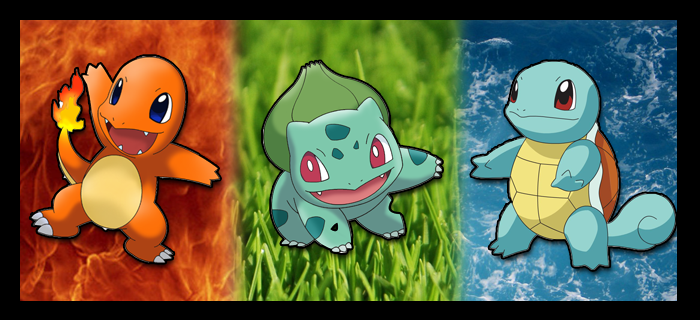Pick a starter pokemon – Embarking on the captivating journey of Pokemon begins with the pivotal decision of choosing a starter Pokemon. This trusted companion will accompany you throughout your adventure, shaping your strategies and shaping your destiny. Dive into this comprehensive guide as we explore the intricacies of selecting the ideal starter Pokemon, empowering you to make an informed choice that aligns with your playstyle and aspirations.
From understanding the characteristics and strengths of starter Pokemon to navigating the factors that influence your decision, this guide delves into the depths of this crucial choice. We will uncover the strategies employed by seasoned trainers and provide insights into the evolution of starter Pokemon designs and abilities across different generations.
Get ready to embark on an adventure filled with excitement and discovery as you discover the perfect starter Pokemon to embark on your epic quest.
Characteristics of Starter Pokemon

Starter Pokemon are the first Pokemon that players choose in the Pokemon franchise. They typically embody the core themes and elements of their respective games. Starter Pokemon often possess unique abilities and characteristics that set them apart from other Pokemon.
Some common traits of starter Pokemon include:
- They are typically unevolved, meaning they have not yet reached their final form.
- They represent one of three types: Grass, Fire, or Water.
- They have balanced stats, making them suitable for a wide range of situations.
- They often have abilities that are useful in the early stages of the game.
Some examples of popular starter Pokemon and their strengths include:
- Charmander (Fire):Strong against Grass and Ice types, with powerful Fire-type moves.
- Squirtle (Water):Strong against Fire and Rock types, with defensive moves like Withdraw and Protect.
- Bulbasaur (Grass):Strong against Water and Ground types, with moves like Vine Whip and Razor Leaf.
Starter Pokemon play a crucial role in the gameplay of the Pokemon franchise. They are the foundation of a player’s team and often accompany them throughout their journey. Choosing the right starter Pokemon can significantly impact the early stages of the game and set the tone for the rest of the adventure.
Factors to Consider When Choosing a Starter Pokemon
When selecting a starter Pokemon, players should consider several factors to optimize their choice.
Type matchups:The type of the starter Pokemon should complement the types of Pokemon that the player is likely to encounter in the early stages of the game. For example, a Grass-type starter is advantageous against Water-type Pokemon, which are common in many early areas.
Team composition:The starter Pokemon should fit well with the other Pokemon that the player plans to add to their team. A balanced team with a variety of types is generally more effective than a team with multiple Pokemon of the same type.
Personal preferences and playstyles:Ultimately, the choice of starter Pokemon is a personal one. Players should consider their own preferences and playstyles when making their decision. For example, players who prefer offensive playstyles may choose a Fire-type starter, while players who prefer defensive playstyles may choose a Water-type starter.
Popular Starter Pokemon and Their Evolutions

| Pokemon | Type | Final Evolution |
|---|---|---|
| Bulbasaur | Grass | Venusaur |
| Charmander | Fire | Charizard |
| Squirtle | Water | Blastoise |
| Chikorita | Grass | Meganium |
| Cyndaquil | Fire | Typhlosion |
| Totodile | Water | Feraligatr |
| Treecko | Grass | Sceptile |
| Torchic | Fire | Blaziken |
| Mudkip | Water | Swampert |
| Turtwig | Grass | Torterra |
| Chimchar | Fire | Infernape |
| Piplup | Water | Empoleon |
| Snivy | Grass | Serperior |
| Tepig | Fire | Emboar |
| Oshawott | Water | Samurott |
| Chespin | Grass | Chesnaught |
| Fennekin | Fire | Delphox |
| Froakie | Water | Greninja |
| Rowlet | Grass | Decidueye |
| Litten | Fire | Incineroar |
| Popplio | Water | Primarina |
| Grookey | Grass | Rillaboom |
| Scorbunny | Fire | Cinderace |
| Sobble | Water | Inteleon |
| Sprigatito | Grass | Meowscarada |
| Fuecoco | Fire | Skeledirge |
| Quaxly | Water | Quaquaval |
Each starter Pokemon has its own unique abilities and strengths. Players should consider their preferences and the factors discussed above when making their choice.
Strategies for Choosing a Starter Pokemon
There are several strategies that players can use to optimize their choice of starter Pokemon.
Consider type advantage:Choosing a starter Pokemon with a type advantage against the first Gym Leader or major boss can give players a significant advantage in the early stages of the game.
Consider long-term evolution:Players should not only consider the immediate abilities of the starter Pokemon but also its final evolution. Some starter Pokemon have stronger evolutions than others, and this should be taken into account when making a choice.
Experiment with different playstyles:There is no one-size-fits-all approach to choosing a starter Pokemon. Players should experiment with different types and playstyles to find what works best for them.
Starter Pokemon in Different Generations: Pick A Starter Pokemon

The starter Pokemon in the Pokemon franchise have evolved over time, both in terms of design and abilities.
| Generation | Pokemon | Types | Description |
|---|---|---|---|
| Generation I | Bulbasaur, Charmander, Squirtle | Grass, Fire, Water | The original starter Pokemon, representing the core elements of the Pokemon franchise. |
| Generation II | Chikorita, Cyndaquil, Totodile | Grass, Fire, Water | Similar to the Generation I starters, but with updated designs and abilities. |
| Generation III | Treecko, Torchic, Mudkip | Grass, Fire, Water | Introduced new abilities and a wider range of moves, expanding the strategic possibilities. |
| Generation IV | Turtwig, Chimchar, Piplup | Grass, Fire, Water | Featured a more diverse range of designs and abilities, including dual-type starter Pokemon. |
| Generation V | Snivy, Tepig, Oshawott | Grass, Fire, Water | Introduced the concept of hidden abilities, giving starter Pokemon additional strategic options. |
| Generation VI | Chespin, Fennekin, Froakie | Grass, Fire, Water | Featured new Mega Evolutions, which temporarily boost the power and abilities of starter Pokemon. |
| Generation VII | Rowlet, Litten, Popplio | Grass, Fire, Water | Introduced Z-Moves, powerful attacks that can be used once per battle, giving starter Pokemon additional options. |
| Generation VIII | Grookey, Scorbunny, Sobble | Grass, Fire, Water | Featured Dynamax and Gigantamax forms, which increase the size and power of starter Pokemon. |
| Generation IX | Sprigatito, Fuecoco, Quaxly | Grass, Fire, Water | Introduced the Terastal phenomenon, which allows starter Pokemon to change their type, adding a new layer of strategy. |
The evolution of starter Pokemon reflects the changing nature of the Pokemon franchise, with new generations introducing new mechanics and features that enhance the gameplay experience.
Common Queries
What are the key characteristics of starter Pokemon?
Starter Pokemon typically possess balanced stats, making them versatile choices for beginners. They often have moves that cover a range of types, ensuring effectiveness against various opponents.
How do I choose the right starter Pokemon for my playstyle?
Consider your preferred battle strategies, team composition, and the type matchups in the region you’ll be exploring. Choose a starter Pokemon that complements your style and provides an advantage against potential opponents.
What are some popular starter Pokemon and their evolutions?
Charmander evolves into Charizard, Squirtle evolves into Blastoise, and Bulbasaur evolves into Venusaur. These classic starter Pokemon have unique strengths and abilities that make them formidable choices.
